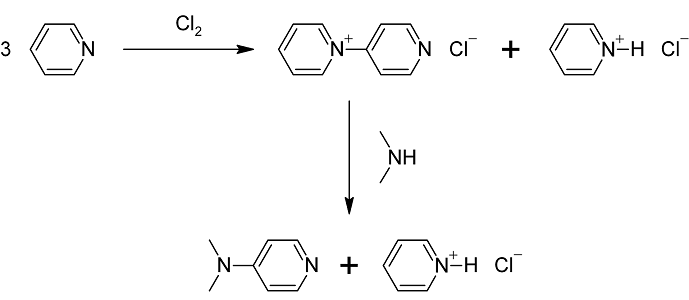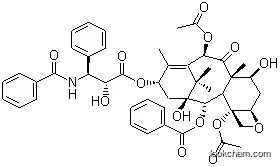Products Categories
| CAS No.: | 1122-58-3 |
|---|---|
| Name: | 4-Dimethylaminopyridine |
| Article Data: | 109 |
| Molecular Structure: | |
|
|
|
| Formula: | C7H10N2 |
| Molecular Weight: | 122.17 |
| Synonyms: | Pyridine, 4-(dimethylamino)-;N,N-Dimethylpyridin-4-amine;4-Pyridinamine, N,N-dimethyl-;N,N-dimethyl-1H-pyridin-4-amine;4-(Dimethylamino)pyridine;p-Dimethylaminopyridine;4-Dimethylamino-pyridine(DMAP);4-Dimethylaminopyridine(DMAP);gamma-(Dimethylamino)pyridine;4-Pyridinamine,N,N-dimethyl-;DMAP (catalyst);4-Dimethylamino pyridine;4-(Dimethylamino) Pyridine;DMAP 4-Dimethylaminopyridine;4-Dimethylaminopy ridine;4-Dimethyl aminopyridine;4-Dimethylaminopyridine DMAP;4-Di(methylamino)pyridine;4-Dimethylamino-pyridine;DMAP (4-Dimethylaminopyridine);4-Dimethylaminopyridine (dmap);4-DMAP;4-Dimethyl amino pyridine;N4,N4-Dimethylpyridin-4-amine;4-(N,N-Dimethylamino)pyridine; |
| EINECS: | 214-353-5 |
| Density: | 1.012 g/cm3 |
| Melting Point: | 83-86 °C(lit.) |
| Boiling Point: | 194.9 °C at 760 mmHg |
| Flash Point: | 71.7 °C |
| Solubility: | miscible with water |
| Appearance: | white to yellow crystalline powder |
| Hazard Symbols: |
 T, T, C, C, T+ T+
|
| Risk Codes: | 25-34-24/25-36/37/38-27-36-24-20-61-40-23/24/25 |
| Safety: | 36/37/39-45-28A-26-28-36/37-53-27-22 |
| Transport Information: | UN 2811 6.1/PG 2 |
| PSA: | 16.13000 |
| LogP: | 1.14760 |
- 144851-82-1METHYL2-AMINO-3-FLUOROBENZOATE
- 483366-12-7(2S,4R)-1-Boc-2-cyano-4-hydroxypyrrolidine
- 173606-50-3BOC-10-AMINODECANOIC ACID
- 361456-36-2METHYL (R)-(+)-ISOCYANATO-3-PHENYLPROPI&
- 5156-58-1N-(1-Benzyl-4-pipperidinyl)-N-phenylpropanamide HCl
- 81281-59-67-Benzylideneaminotheophylline
- 50288-62-5threo-Phenyl-2-piperidyl acetamide
- 82993-81-5D-threo-Ritalinic acid hydrochloride
- 47087-37-6Z-D-Glu-OMe
- 1219080-61-1IMIDAZOLE-2-BORONIC ACID

| Conditions | Yield |
|---|---|
| Stage #1: pyridine-4-carbonitrile With hydrogenchloride; acrylic acid at 90℃; for 1.5h; Inert atmosphere; Stage #2: dimethyl amine at 70℃; for 2.5h; Inert atmosphere; Stage #3: With sodium hydroxide at 70 - 90℃; for 3.5h; Temperature; Reagent/catalyst; Inert atmosphere; | 99.4% |
| Stage #1: pyridine-4-carbonitrile With hydrogenchloride; acrylic acid In water at 70℃; for 4h; Inert atmosphere; Stage #2: dimethyl amine In water at 50℃; for 3h; Temperature; Inert atmosphere; | 99% |
| Stage #1: pyridine-4-carbonitrile With hydrogenchloride; hydroquinone; acrylic acid In water at 90℃; for 6h; Stage #2: dimethyl amine In water for 3h; Temperature; Reflux; | 98.6% |

| Conditions | Yield |
|---|---|
| With bis(triphenyl)oxodiphosphonium trifluoromethanesulfonate salt; potassium iodide In ethanol at 20℃; for 1h; | 95% |
| With phenylboronic acid In 1,2-dichloro-ethane at 120℃; for 10h; | 90% |
| With 1,1,1,2,2,2-hexamethyldisilane; tetrabutyl ammonium fluoride In tetrahydrofuran at 24 - 30℃; for 8h; | 84% |

| Conditions | Yield |
|---|---|
| With sodium hydroxide; water In 1,4-dioxane at 70℃; under 6000480 Torr; for 20h; Substitution; | 93% |

| Conditions | Yield |
|---|---|
| With copper(l) iodide; 6,7-dihydro-5H-quinolin-8-one oxime; potassium hydroxide In water at 25℃; for 24h; Inert atmosphere; | 90% |

| Conditions | Yield |
|---|---|
| In methanol at 40 - 45℃; for 4h; Autoclave; | 89.7% |

| Conditions | Yield |
|---|---|
| With N,N,N,N,-tetramethylethylenediamine In toluene at -40 - 20℃; for 1.5h; Substitution; | 86% |

| Conditions | Yield |
|---|---|
| With aluminum (III) chloride; water In acetonitrile at 20℃; Irradiation; | 86% |
| With palladium 10% on activated carbon; potassium tert-butylate at 150℃; for 48h; |

| Conditions | Yield |
|---|---|
| With potassium hydroxide In neat (no solvent) at 100℃; for 24h; Sealed tube; | 82% |

| Conditions | Yield |
|---|---|
| With ammonia In water at 240℃; for 0.5h; | 78% |

| Conditions | Yield |
|---|---|
| With potassium carbonate at 80℃; for 10h; | 75% |
| for 34h; Reflux; neat (no solvent); | 69% |
| With potassium hydroxide In neat (no solvent) at 100℃; for 24h; Sealed tube; | 21 %Spectr. |
- 162401-32-3Benzamide,3-(cyclopropylmethoxy)-N-(3,5-dichloro-4-pyridinyl)-4-(difluoromethoxy)-
- 110-63-41,4-Butanediol
- 27176-87-0Dodecyl benzene sulfonic acid
- 67-48-1Choline chloride
- 2058-46-0Oxytetracycline hydrochloride
- 8009-03-8Petrolatum
- 108-46-3Resorcinol
- 9003-01-42-Propenoic acid, homopolymer
- 104987-11-3Tacrolimus
- 141-53-7Sodium formate
- 8001-54-5Quaternary ammonium compounds, alkylbenzyldimethyl, chlorides
- 9003-39-8Povidone
- 10161-34-9Trenbolone acetate
- 402957-28-2Telaprevir
- 68-19-9Cyanocobalamin

What can I do for you?
Get Best Price
Specification
The 4-Dimethylaminopyridine, with the CAS registry number 1122-58-3,is also known as N,N-Dimethylpyridin-4-amine; DMAP. It belongs to the product categories of Nucleotides;Amines;Aromatics. This chemical's molecular formula is C7H10N2 and molecular weight is 122.17.Its EINECS number is 214-353-5. What's more,Its systematic name is 4-(Dimethylamino)pyridine .It is a White solid which is stable,incompatible with acids,oxidizing agents. It is a highly efficient catalyst for acylation reactions.Its analogues are used in kinetic resolution experiments of mainly secondary alcohols and Evans auxilar type amides.
Physical properties about 4-Dimethylaminopyridine are:
(1)ACD/LogP: 1.34; (2)# of Rule of 5 Violations: 0; (3)ACD/LogD (pH 5.5): -1.15; (4)ACD/LogD (pH7.4): -0.63; (5)ACD/BCF (pH 5.5): 1.00; (6)ACD/BCF (pH 7.4): 1.00; (7)ACD/KOC (pH 5.5): 1.00; (8)ACD/KOC (pH 7.4): 1.37; (9)#H bond acceptors: 2; (10)#H bond donors: 0; (11)#Freely Rotating Bonds: 1; (12)Index of Refraction: 1.554; (13)Molar Refractivity: 38.658 cm3; (14)Molar Volume: 120.648 cm3;(15)Surface Tension: 40.0180015563965 dyne/cm; (16)Density: 1.013 g/cm3; (17)Flash Point: 71.687 °C; (18)Enthalpy of Vaporization: 43.112 kJ/mol; (19)Boiling Point: 194.922 °C at 760 mmHg; (20)Vapour Pressure: 0.430999994277954 mmHg at 25°C.
You can still convert the following datas into molecular structure:
(1)SMILES:n1ccc(N(C)C)cc1;
(2)Std. InChI:InChI=1S/C7H10N2/c1-9(2)7-3-5-8-6-4-7/h3-6H,1-2H3;
(3)Std. InChIKey:VHYFNPMBLIVWCW-UHFFFAOYSA-N.
Preparation of 4-Dimethylaminopyridine :
4-Dimethylaminopyridine can be prepared in a two-step procedure from pyridine, which is first oxidized to 4-pyridylpyridinium cation. This cation then reacts with dimethylamine:

Safety Information of 4-Dimethylaminopyridine:
The 4-Dimethylaminopyridine is toxic by inhalation, in contact with skin and if swallowed and Irritating to eyes, respiratory system and skin. It is harmful by inhalation. And it may cause harm to the unborn child. There is limited evidence of a carcinogenic effect. In case of accident or if you feel unwell, seek medical advice immediately (show the label whenever possible.) .When you use it wear suitable protective clothing, gloves and eye/face protection. Avoid exposure - obtain special instructions before use. After contact with skin, wash immediately with plenty of soap-suds. In case of contact with eyes, rinse immediately with plenty of water and seek medical advice. And take off immediately all contaminated clothing.
The toxicity data of 4-Dimethylaminopyridine as follows:
| Organism | Test Type | Route | Reported Dose (Normalized Dose) | Effect | Source |
|---|---|---|---|---|---|
| mouse | LD50 | intravenous | 56mg/kg (56mg/kg) | U.S. Army Armament Research & Development Command, Chemical Systems Laboratory, NIOSH Exchange Chemicals. Vol. NX#04228, | |
| mouse | LDLo | oral | 470mg/kg (470mg/kg) | Archives of Environmental Contamination and Toxicology. Vol. 14, Pg. 111, 1985. | |
| rabbit | LD50 | skin | 13mg/kg (13mg/kg) | National Technical Information Service. Vol. OTS0536502, | |
| rat | LD50 | oral | 250mg/kg (250mg/kg) | National Technical Information Service. Vol. OTS0536502, |




